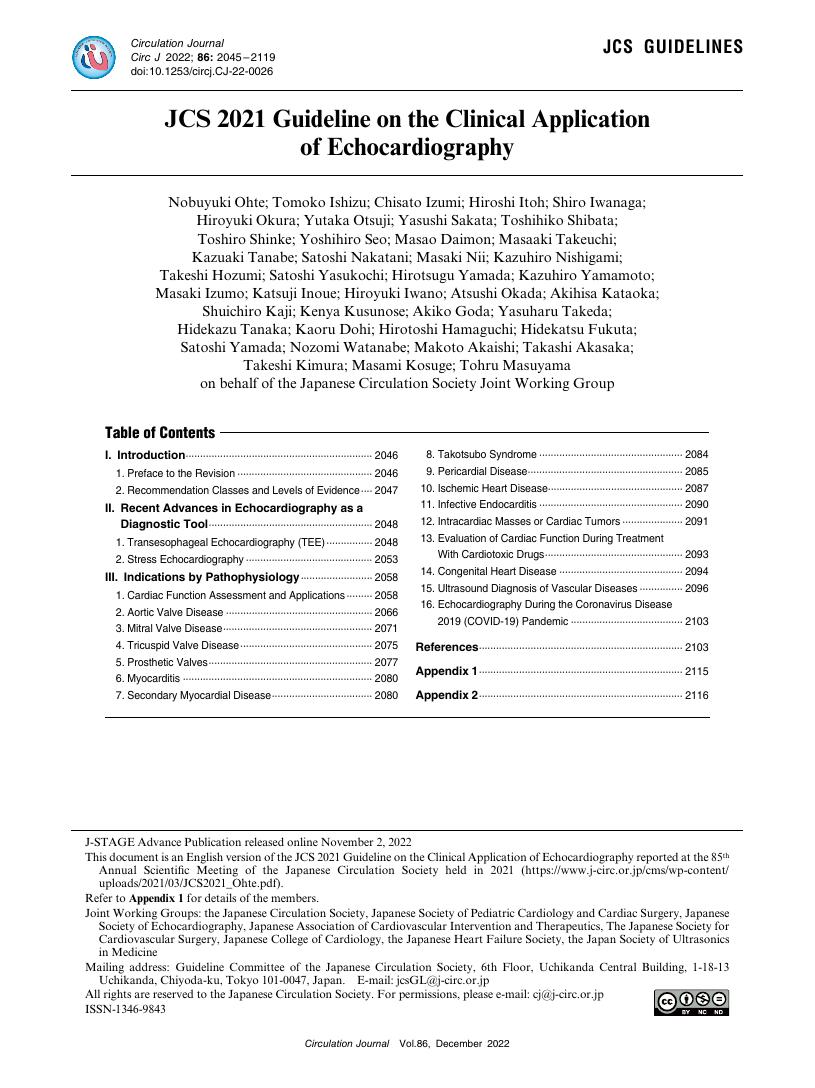- 著者
- Nobuyuki Ohte Tomoko Ishizu Chisato Izumi Hiroshi Itoh Shiro Iwanaga Hiroyuki Okura Yutaka Otsuji Yasushi Sakata Toshihiko Shibata Toshiro Shinke Yoshihiro Seo Masao Daimon Masaaki Takeuchi Kazuaki Tanabe Satoshi Nakatani Masaki Nii Kazuhiro Nishigami Takeshi Hozumi Satoshi Yasukochi Hirotsugu Yamada Kazuhiro Yamamoto Masaki Izumo Katsuji Inoue Hiroyuki Iwano Atsushi Okada Akihisa Kataoka Shuichiro Kaji Kenya Kusunose Akiko Goda Yasuharu Takeda Hidekazu Tanaka Kaoru Dohi Hirotoshi Hamaguchi Hidekatsu Fukuta Satoshi Yamada Nozomi Watanabe Makoto Akaishi Takashi Akasaka Takeshi Kimura Masami Kosuge Tohru Masuyama on behalf of the Japanese Circulation Society Joint Working Group
- 出版者
- The Japanese Circulation Society
- 雑誌
- Circulation Journal (ISSN:13469843)
- 巻号頁・発行日
- vol.86, no.12, pp.2045-2119, 2022-11-25 (Released:2022-11-25)
- 参考文献数
- 460
- 被引用文献数
- 16
- 著者
- Masato Okada Kazunori Kashiwase Akio Hirata Mayu Nishio Yasuharu Takeda Takayoshi Nemoto Ryohei Amiya Yasunori Ueda Yoshiharu Higuchi Yoshio Yasumura
- 出版者
- The Japanese Circulation Society
- 雑誌
- Circulation Journal (ISSN:13469843)
- 巻号頁・発行日
- vol.83, no.1, pp.56-66, 2018-12-25 (Released:2018-12-25)
- 参考文献数
- 31
Background: Identifying who among current Japanese patients with prior myocardial infarction (MI) would benefit from an implantable cardioverter-defibrillator (ICD) is imperative. Accordingly, this study seeks to determine whether single-photon emission computed tomography (SPECT) can help identify such patients. Methods and Results: This retrospective study enrolled 60 consecutive patients with prior MI who underwent stress thallium-201 SPECT and ICD implantation from February 2000 to October 2014. Occurrence of arrhythmic death and/or or appropriate ICD therapy, defined as shock or antitachycardia pacing for ventricular fibrillation or tachycardia, was identified until November 2016. During the median follow-up interval of 6.6 years, 18 (30%) patients experienced arrhythmic death and/or appropriate ICD therapy. Multivariate Cox proportional hazard regression analysis revealed that the summed stress score (SSS) [hazard ratio (HR)=1.14; P=0.005] and left ventricular ejection fraction (LVEF) at rest (HR=0.92; P=0.038) were significantly associated with the occurrence of arrhythmic events. Patients with SSS ≥21 and LVEF ≤30%, which were determined to be the best cutoff points, had significantly higher incidence of the arrhythmic events than the other patients (64% vs. 11%; HR=7.18; log-rank P=0.001). Conclusions: SSS using stress thallium-201 SPECT in combination with LVEF can help determine the need for ICD therapy among current Japanese patients with prior MI.
- 著者
- Masato Okada Kazunori Kashiwase Akio Hirata Yasuharu Takeda Ryohei Amiya Yasunori Ueda Yoshiharu Higuchi Yoshio Yasumura
- 出版者
- International Heart Journal Association
- 雑誌
- International Heart Journal (ISSN:13492365)
- 巻号頁・発行日
- vol.59, no.6, pp.1275-1287, 2018-11-30 (Released:2018-11-28)
- 参考文献数
- 38
- 被引用文献数
- 2 2
Right ventricular apical (RVA) pacing often causes left ventricular (LV) mechanical asynchrony, which is enhanced by impaired cardiac contraction and intrinsic conduction abnormality. However, data on patients with normal cardiac function and under RV non-apical (non-RVA) pacing are limited.We retrospectively investigated 97 consecutive patients with normal ejection fraction who received pacemaker implantation for atrioventricular block with the ventricular lead placed in a non-RVA position. We defined mechanical asynchrony as discoordinate contraction between opposing regions of the LV wall evaluated by echocardiography. Asynchrony was detected in 9 (9%) patients at baseline and in 38 (39%) under non-RVA pacing (P < 0.001). Asynchrony at baseline was significantly associated with complete left bundle branch block (CLBBB) [odds ratio (OR) = 20.8, P < 0.001]. Asynchrony under non-RVA pacing was significantly associated with left anterior fascicular block (LAFB) (OR = 7.14, P < 0.001) and CLBBB (OR = 13.3, P = 0.002) at baseline. New occurrence of asynchrony was significantly associated with LAFB at baseline (OR = 5.88, P = 0.001). During a median follow-up period of 4.8 years, the incidence of device-detected atrial fibrillation (AF) was more frequent in patients who developed asynchrony than in those who did not (53.3% versus 27.5%, hazard ratio = 2.17, 95% confidence interval = 1.02-4.61, P = 0.03).In patients with normal cardiac function, LAFB at baseline was significantly associated with new occurrence of mechanical asynchrony under non-RVA pacing. Abnormal contraction had a significant influence on the incidence of device-detected AF.
